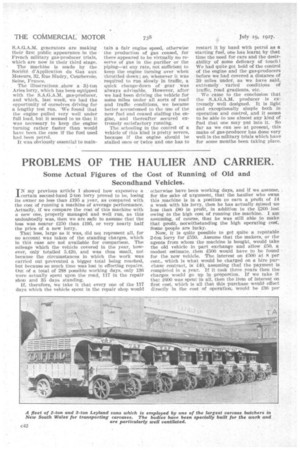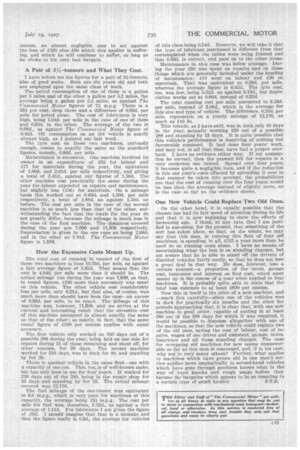PROBLEMS OF THE HAULIER AND CARRIER.
Page 64

Page 65

If you've noticed an error in this article please click here to report it so we can fix it.
Some Actual Figures of the Cost of Running of Old and Secondhand Vehicles.
my previous article I showed how expensive a certain second-hand 2-ton lorry proved to be, losing its owner no less than £195 a year, as compared with the cost of running a machine of average. performance. Actually, if we compare the cost of this machine with a new one, properly managed and well run, as this undoubtedly was, then we are safe to assume that the loss was nearer £250 than £195, or very nearly half the price of a new lorry.
That loss, large as it was, did not represent all, for no account was taken of the standing charges, which in thiS case are not available for comparison. The mileage which the vehicle covered in the year, however, only totalled 5.420, and was thus small, not because the circumstances in which the work was carried out prevented a bigger total being reached, but because so much time was lost in effecting repairs. Out of a total of 288 possible working days, only 136 were actually spent upon the road, 117 in the repair shop and 35 days standing.
If, therefore, we take it that every one of the 117 days which the vehicle spent in the repair shop would Wherwise have been working days, and if we assume, for the sake of argument, that the haulier who owns this .machine is in a position to earn a profit of £4 a week with his lorry, then he has actually missed no less than £80 in profit, in addition to the £200 lost owing to the high cost of running the machine. I am assuming, of course, that he was still able to make that profit, notwithstanding the high operating cost. Some people are lucky.
Now, it is quite possible to get quite a reputable 2-ton lorry for £550. Assume that the makers, or the agents from whom the machine is bought, would take the old vehicle in part exchange and allow £50, a modest estimate, then £500 would have to be found for the new vehicle. The interest on £500 at 8 per cent., which is what would be charged on a hire purchase contract, is £40, assuming thaf the payment is completed in a year. If it took three years then the charges would go up in proportion. If we take it that £600 was spent in all, then the item of interest on first cost, which is all that this purchase would effect directly in the cost of operation, would be 136 per annum, an almost negligible sum to set against the loss of £195 plus £80 which this haulier is suffering, and which he will continue to suffer., so long as he sticks to his very bad bargain.
A Pair of 3Y2.-tonners and What They Cost.
I have before me the figures for a pair of 3A-tonners, also of good make. Both are six years old and both are employed upon the same class of work.
The petrol consumption of one of them is a gallon per 5 miles and of the other a gallon per 5.2 miles, the average being a gallon per 5.1 miles, as against The Commercial Motor figures of 7+ m.p.g. There is a 33+ per cent. drop there and a difference of 0.83d. per mile for petrol alone. The cost of lubricants is very high, being 1.04d, per mile in the ease of one of them and 0.92d. in the other. The average of the two is 0.98d., as against The Commercial Motor figure of 0.42d. Oil consumption on an old vehicle is nearly always high, as I pointed out last week.
The tyre cost on these two machines, curiously enough, comes to exactly the same as the standard figures, namely, 0.80d. per mile.
Maintenance is excessive. One machine involved its owner in an expenditure of £32 for labour and £77 for materials during the year, the equivalent of 1.00d. and 2.41d. per mile respectively, and giving a total of 3.41d., against our figures of 1.50d. The other machine cost practically the same during the year for labour expended on repairs and maintenance. but slightly less (156) for materials. On a mileage basis this worked out at 0.68d. and 1.20d. per mile respectively, a total of 1.88d, as against 1.50d. as before. The cost per mile in the case of the second machine is so much less than that of the other, notwithstanding the fact that the totals for the year do not greatly differ, because the mileage is much less in the ease of the first machine. The distances covered during the year are 7,699 and 11,308 respectively. Depreciation is given in the one case as being 2.68d. and in the other as 1.81d. The Commercial Motor figure is 1.10d.
How the Excessive Costs Mount Up.
The total test or running in respect of the first of these two machines is thus 10.79d. per mile, as against a fair average figure of 5.85d. That means that the cost is 4.94d. per mile more than it should be. The actual mileage run dering the year was 7,699, so that, in round figures, £160 more than necessary was spent on this vehicle. The other vehicle cost considerably Tess per mile, only 8.21d., but that also, of course, was much more than should have been the case—an excess of 3.36d. per mile, to be exact. The mileage of this machine was, however, 11,308, and we arrive at the curious and interesting result that the excessive cost of this machine amounted to almost exactly the same as that of the other; so nearly, in fact, that the 'same round figure of £160 per annum applies with equal
• accuracy.
The first vehicle only worked on 195 days out of 'a possible 288 during the year, being laid on one side for repairs during 55 of those remaining and stood off, for other reasons, for 38 days. The second machine worked for 219 days, was in dock for 40, and standing by for 29.
There is another vehicle in the same fleet—one with a capacity of One ton. This, too, is of well-known make, but has only been in use for four years. It worked for 259 days out of the 288, being in the repair shop for 16 days and standing by for 13. The actual mileage covered was 12,176.
The fuel mileage of the one-tonner was equivalent to 9.6 m.p.g., which is very poor for machines of this capacity, the average being 13+ m.p.g. The cost per mile for fuel was, therefore, 1.52d., as against a fair average of 1.11d. For lubricants I am given the figure of .03d. I should imagine that that is a mistake and that the figure really is 0.3d., the average for vehicles of this class being 0.24d. However, we will take it that the type of lubricant purchased is different from that contemplated when the tables were being framed and that 0.03d. is correct, and pass on to the other items.
Maintenance in this case was below average. During the year £30 was spent on repairs and on those things which are generally included under the heading of maintenance; £10 went on labour and £20 on materials. That was equivalent to 0.59d. per mile, whereas the average figure is 0.65i1 The tyre cost, too, was low, being 0.52d. as against 0.74d., but depreciation works out at 0.60d, instead of 0.32d.
The total running cost per mile amounted to 3.260. per mile, instead of 3.06d., which is the average for this size and type of vehicle. The difference, 0.20d. per mile, represents, on a yearly mileage of 12,176, as much as £10 3s.
This vehicle, as I have said, was in dock only 16 days in the year. actually working 259 out of a possible 288 and standing by 13 days. It is quite possible that this vehicle's performance is deserving of nothing but favourable comment. It had done four years' work, and may not, in all that time, have had a -proper overhaul. I have no evidence either way. If my assumption be correct, then the present bill for repairs is a very moderate one indeed. Spread over four years, it becomes quite a negligible item, and if the reduction in this one year's costs effected by spreading it over in that manner be taken into account, the probabilities are that the cost of running over the four years would be less than the average instead of slightly more, as is the case so far as the evidence shows.
One New Vehicle Could Replace Two Old Ones.
On the other hand, it is equally passible that the chassis has had its fair meed of attention during its life and that it is now beginning to show the effects of increasing age. I think, at any rate, that I am justified in assuming, for the preseht, that eomething of the sort has taken place, so that, on the whole, we may say that this man, in running this fleet of four old machines, is spending, in all, £525 a year more than he need do on running coats alone. I have no means of ascertaining what the losa is on standing charges, but am aware that he is able to stand off the drivers of disabled vehicles fairly easily, so that he does not lose a great deal in that way. He does, however, lose a. certain amount—a proportion of the taxes, garage rent, insurance and interest on first cost, which must mount up in the course of a year when applied to four machines. It is probably quite safe to state that the total loss aniounts to at least £600 per annum.
Now this in itself is the price of a new machine, and —mark this carefully—since one of the vehicles was in dock for practically six months and the other for periods approaching that, it is clear that, with one new machine in good order, capable of putting in at least 280 out of the 288 days for which it was required, it would be possible to dispense altogether with one of the machines, so that the new vehicle could replace two of the old ones, saving the cost of labour, cost of repairs, wages of one driver and assistant, garage, taxes, insurance and all those standing charges. The case for scrapping old machines for new seems unanswerable so far as this man is concerned, and, if in his cage; why not in .very many others? Further, what applies to machines which have grown old in one man's service applies more emphatically to second-hand Vehicles which have gone through goodness knows what in the way of hard knocks and rough usage before they become the bargains which appear to be so tempting to
a certain type of email haulier. S.T.R.












































































































